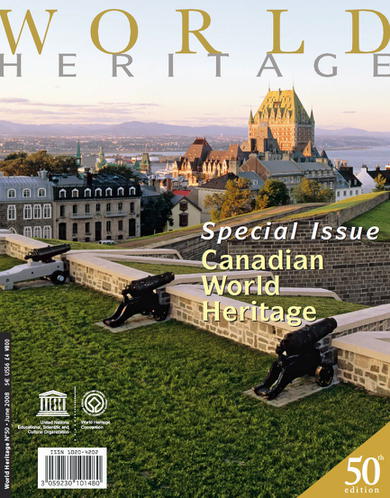The 14 World Heritage sites of Canada presented in this issue offer a fascinating pattern. Indeed, they reflect key aspects of the evolution of the very concept of World Heritage over the past 32 years.
The sites predictably include historic cities like Old Québec and Lunenburg, great natural sites like Nahanni National Park, Wood Buffalo National Park, the Canadian Rocky Mountain Parks and Gros Morne National Park; transboundary sites such as Kluane/Wrangell-St. Elias/Glacier Bay/Tatshenshini-Alsek and Waterton Glacier International Peace Park; sites of paramount importance to palaeontology like Dinosaur Provincial Park and Miguasha National Park; but also sites of historic interest such as SGang Gwaay, a moving testimony to the enduring culture of the Haida people, the spectacular Head-Smashed-In Buffalo Jump, the early 19th-century feat of engineering of the Rideau Canal, and the modest but fascinating 11th-century Viking settlement of L’Anse-aux-Meadows in Newfoundland.
It is significant that some of these sites are jointly managed by Parks Canada and representatives of First Nations. In others, where there is no formal cooperative management mechanism with Aboriginal people, Parks Canada is nonetheless making increased efforts to engage them in the protection, conservation and presentation of this heritage. These efforts represent an important evolution in the relationship between different cultures and their shared responsibilities for protecting heritage in the present context of the world.
The idea of World Heritage evolved in a highly significant manner over the years, as it became increasingly apparent that not all cultures and civilizations built monuments of stone, and that unique sites could also bear the imprint of human action and history in far more discreet forms. It was thus recognized that certain striking topographical features could be seen to embody a spiritual vision.
This realization led to the increasingly interesting concept of the ‘cultural landscape’. With this came the attendant notion of cultural diversity and the need for its preservation – a need that is clearly apparent in the Canadian approach to World Heritage issues.
Tourism also exposes cultures to certain risks, since tourists may be tempted to visit the world armed with their own assumptions. We should therefore be at pains to remind them that each culture was shaped to deal with the truly fundamental issue that confronts every society: how do we cope with the human condition in the particular context in which history and geography have placed us?
All cultures have a story that attempts to deal with that sort of question. And the nature of that story commands the shape of the language people speak and the thoughts they are capable of thinking. This is the basis of cultural diversity. It is also one of the challenges confronting our present global society. The Canadian World Heritage community has developed a brave and honest response to it.
Table of Contents
- Message from UNESCO Director-General Mr Koïchiro Matsuura
- Map of Canada.
- In Focus
- Nahanni National Park
- L'Anse aux Meadows National Historic Site
- Dinosaur Provincial Park
- Kluane/Wrangell-St Elias/Glacier Bay/Tatshenshini-Alsek
- Head-Smashed-In Buffalo Jump
- SGang Gwaay
- Wood Buffalo National Park
- Canadian Rocky Mountain Parks
- Historic District of Old Québec
- Gros Morne National Park
- Old Town Lunenburg 34
- Waterton-Glacier International Peace Park
- Miguasha National Park
- Rideau Canal
- Interview
Interview with Dr Christina Cameron, Chair of the 32nd session of the World Heritage Committee - Close-Up
- Canada's Tentative List for World Heritage sites
- The number of potential World Heritage sites in Canada far exceeds the 14 already inscribed on the World Heritage List
- Conventions
European Landscape Convention: Fostering sustainable development through planning; Third World Congress of Biosphere Reserves Meets in Madrid - News
- Preservation
Fire Damages Historic Landmarks in Italy and Canada; Bridge Proposal Reviewed by International Mission; Lalibela Conservation Action Plan; Protecting Fossils; World Heritage and Buffer Zones; Aksum Obelisk Re-installation Project - In Danger
New Mission to Dresden Elbe Valley; Curbing and Eliminating Invasive Species in Galápagos - Outreach
Science and Technology in World Heritage; New Episode of Patrimonito's World Heritage Adventures on Protecting Mountain Gorillas; Congo Meeting Identifies Outstanding Protected Areas in Central Africa; Hyrcanian Forest Joint Nomination; Sharing Our Heritages - In Print & Online
A selection of books, brochures and publications, press articles and multimedia dedicated to World Heritage.











